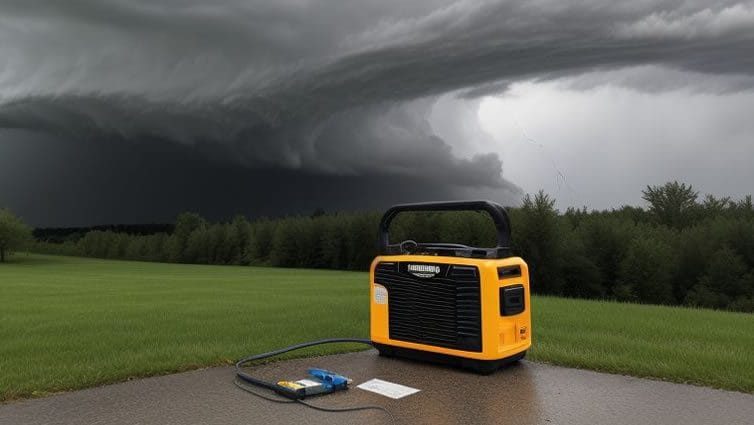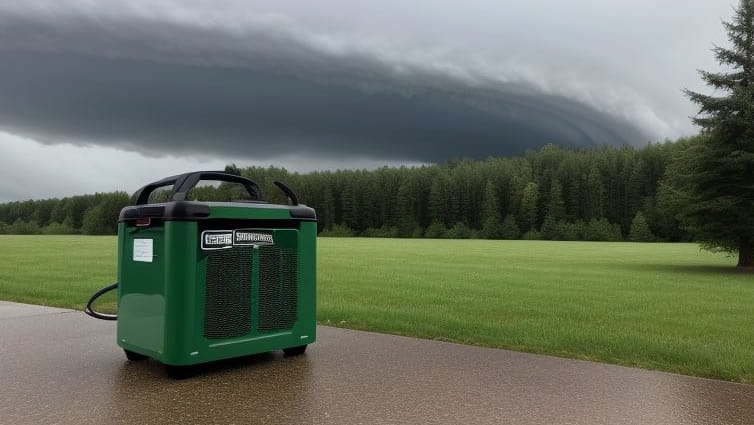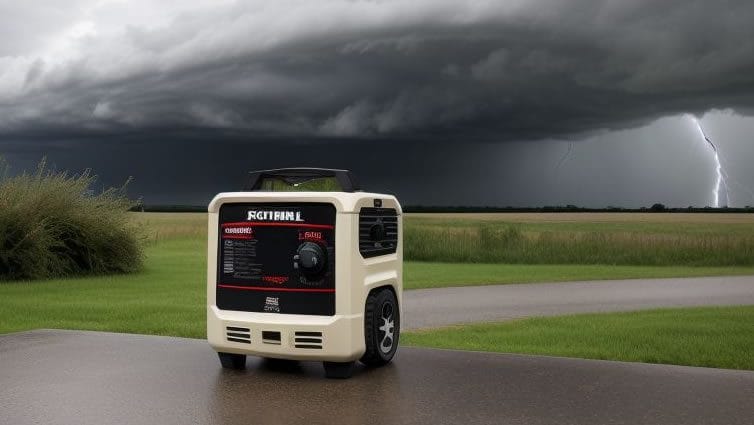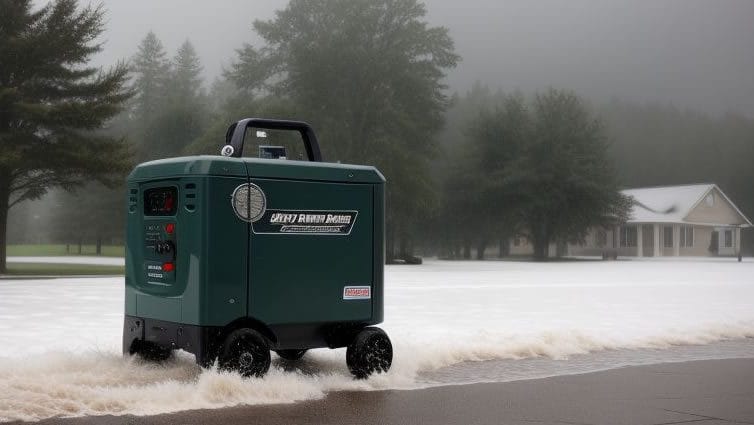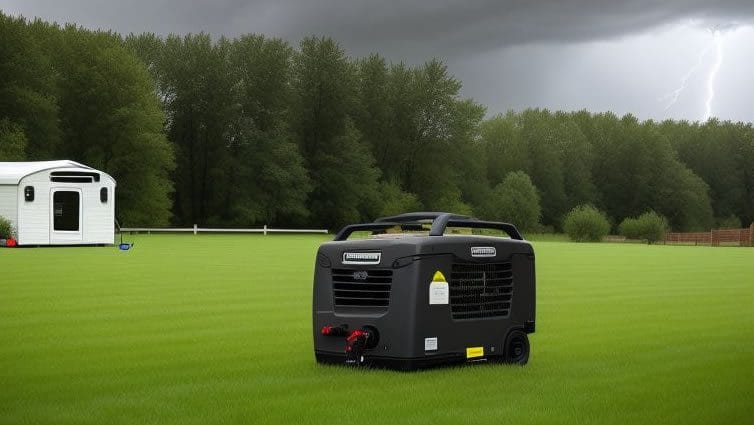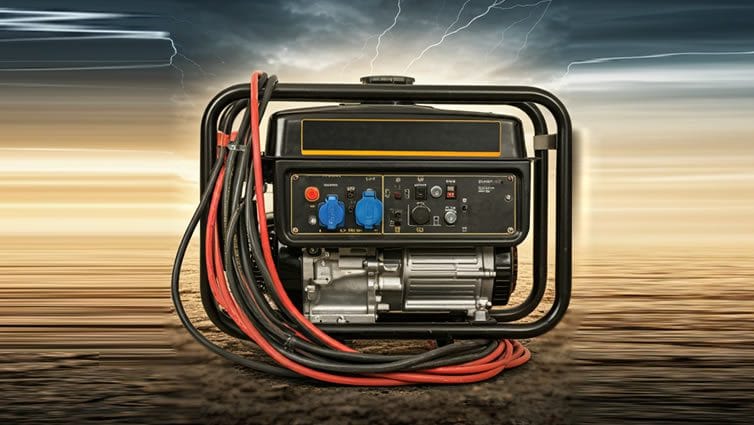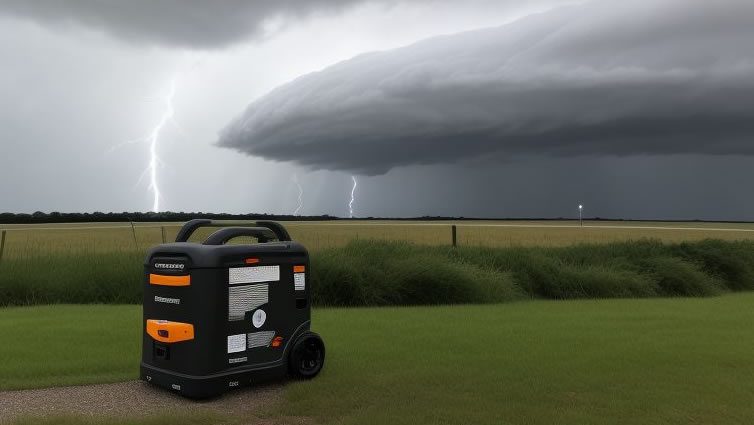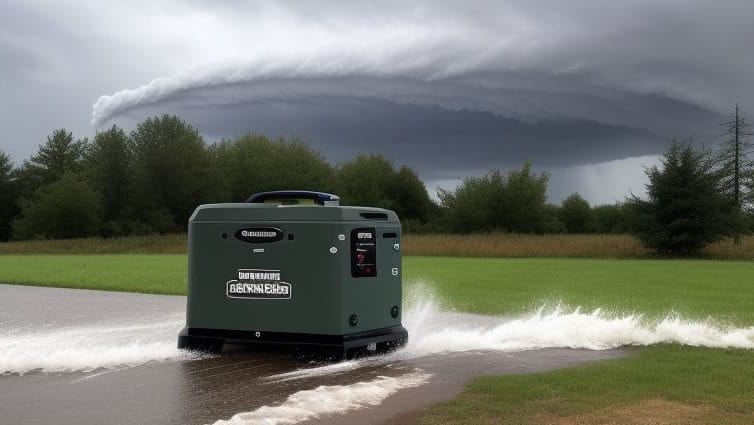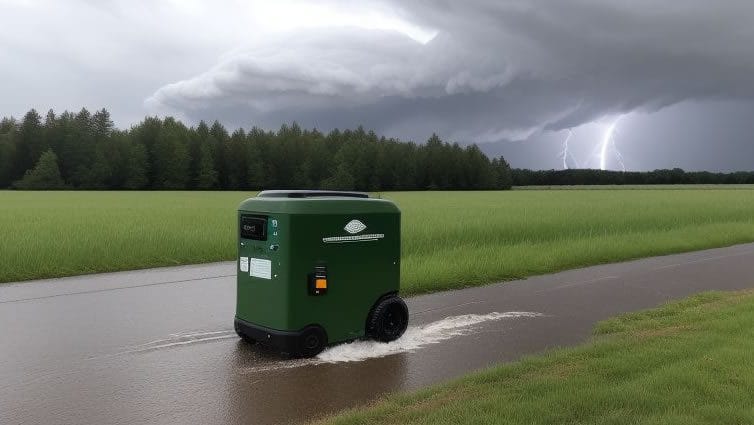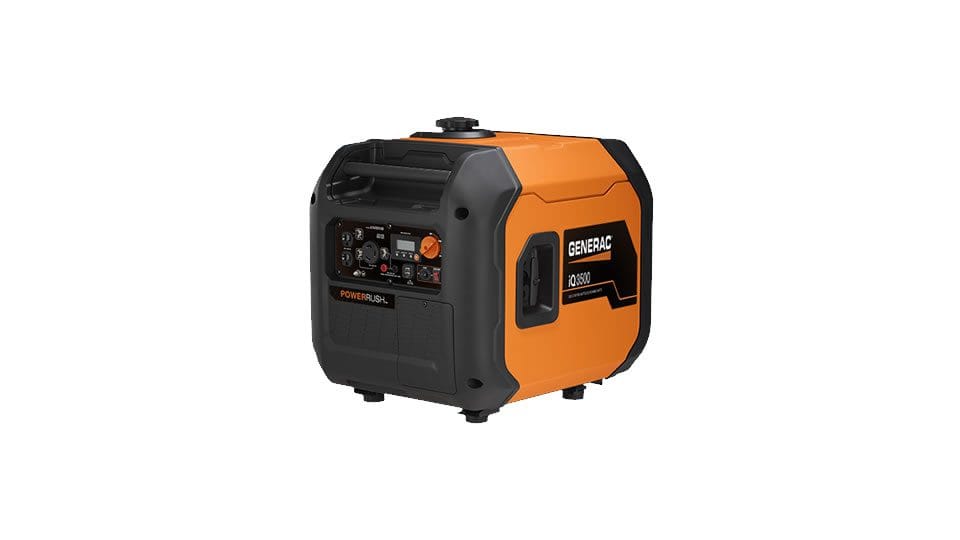Portable Generator: Key Features for Emergency Preparedness
When the power goes out, having a portable generator can make all the difference. You want to ensure that it’s not just any generator but one that fits your needs perfectly. So, what features should you look for in an emergency portable generator? Let’s break it down to help you make the best choice!
Power Output: The Heart of Your Generator
One of the first things to consider is the power output of your portable generator. This is measured in watts and determines how many appliances you can run simultaneously. If you plan to power essential items like your refrigerator, lights, and maybe even your TV, you’ll need a generator with sufficient wattage.
Most household essentials require between 1,000 to 5,000 watts. For instance, a refrigerator may need around 1,500 watts, while lights might only require 100 watts each. To avoid any surprises, calculate your total wattage needs before shopping. Look for generators that offer at least 20% more power than your maximum requirements to ensure you can run everything comfortably.
Fuel Type: Choose What Works for You
Next up is the fuel type. Portable generators typically run on gasoline, propane, or diesel. Each fuel type has its pros and cons, so think about what suits your situation best. Gasoline is readily available, but it can go stale if stored for too long. Propane, on the other hand, has a longer shelf life and burns cleaner, making it a great option for extended use.
Some portable generators offer dual-fuel capabilities, allowing you to switch between gasoline and propane. This feature gives you flexibility during emergencies. Imagine running out of gas in the middle of a storm! Having the option to use propane can save the day and keep your essential devices running smoothly.
Portability: Don’t Break Your Back!
Now, let’s talk about portability. The whole point of a portable generator is that it’s easy to move around, right? Look for models with wheels and sturdy handles. You want a generator that you can easily roll out of your garage or shed and into your backyard. After all, you might need it for outdoor activities as well.
Check the weight of the generator before purchasing. If you’re not a bodybuilder, you probably don’t want a generator that weighs more than a small car. Models that weigh around 100 to 200 pounds are often manageable for most people. Don’t forget about size, too. A compact generator will fit more easily in your vehicle and take up less space in your garage.
Noise Level: Keep It Down
Nobody likes a noisy generator, especially during a power outage when you might want some peace and quiet. When looking for a portable generator, pay attention to its noise level, measured in decibels (dB). Many modern generators are designed to run quietly, usually around 50 to 60 dB, which is similar to the sound of a normal conversation.
Look for models that boast “quiet technology” or have built-in soundproofing features. This is especially important if you’re using your generator at night. The last thing you want is to keep your family and neighbors awake while you’re trying to keep the lights on!
Runtime: How Long Can It Go?
Another vital feature to consider is runtime. This tells you how long your generator can run on a full tank of fuel. It’s essential to have a generator that can last through the night or for several days, depending on your needs. Most portable generators will run anywhere from 8 to 12 hours on a full tank, but this can vary based on the load you’re putting on the generator.
To extend runtime, consider models with larger fuel tanks or energy-efficient engines. You don’t want to be refueling every few hours during a long power outage. Look for generators that give you the best combination of runtime and power output, ensuring you can keep your essentials running as long as possible.
Additional Features: The Cherry on Top
Lastly, consider any additional features that can make your generator experience even better. Some generators come with built-in outlets for USB devices, allowing you to charge your phone without needing an adapter. Others may have automatic shut-off features when oil levels are low or when the generator is overloaded.
Look for generators with easy-start mechanisms, whether it’s a simple pull cord or an electric start option. These little conveniences can make a big difference when you need power fast. Also, check if the generator has a display panel that shows runtime, fuel level, and wattage usage.
How to Safely Store and Handle Fuel for Emergency Generators
When you own a portable generator, knowing how to store and handle fuel is crucial. After all, you want your generator ready to go when an emergency strikes. Improper storage can lead to safety hazards or fuel deterioration. So let’s dive into some practical tips for safely storing and handling fuel for your portable generator!
Choose the Right Fuel Type
First things first—what type of fuel are you using? Most portable generators run on gasoline, but some can use propane or diesel. Gasoline is often the most readily available, but it has a short shelf life. If you plan to store fuel for long periods, consider using propane. Propane can last for years without losing its effectiveness.
If you decide to go with gasoline, look for fuel that has no ethanol. Ethanol-blended fuel can attract moisture and cause corrosion in your generator. You want to keep your portable generator in top shape, right? Using the right fuel can make a huge difference in its performance and longevity.
Store Fuel in Approved Containers
Next, always store your fuel in approved containers. These containers are specifically designed to safely hold fuel without leaking or causing fire hazards. Look for containers that are labeled for gasoline or propane. Avoid using old soda bottles or other makeshift containers, as they can break easily and create serious risks.
When purchasing a fuel container, consider the size. A 5-gallon container is a good option for home use, as it’s manageable and fits easily in most storage spaces. If you’re planning to stock up, just remember that larger containers may be harder to handle. Safety should always be your top priority when dealing with fuel!
Find a Safe Storage Location
Now that you have the right fuel and container, let’s talk about where to store it. Choose a cool, dry place away from direct sunlight. The garage or a shed can work, but make sure the area is well-ventilated. Storing fuel indoors can create risks, especially if there’s a leak.
Never store fuel near sources of heat or open flames, such as a furnace or water heater. A little common sense goes a long way in keeping your home and family safe. If you can, use a locked cabinet or storage box to keep fuel out of reach of kids and pets. Safety first, right?
Label Everything Clearly
Labeling your fuel containers is another great practice. This might seem like a small detail, but it can prevent serious accidents. Use a permanent marker to clearly mark each container with the type of fuel inside. This way, you won’t mix up gasoline and propane when you’re in a hurry.
Additionally, if you’re storing fuel for a long time, note the purchase date. Fuel has a shelf life, and knowing how old it is can help you decide when to use it. Using the oldest fuel first ensures you’re always using fresh fuel, maximizing your generator’s performance.
Handle Fuel with Care
When it’s time to refuel your portable generator, make sure to handle the fuel with care. First, always turn off the generator and let it cool down. Refueling a hot generator can lead to dangerous situations, like fires or explosions. Safety is key!
Use a funnel when pouring fuel into the generator. This simple tool can help prevent spills and keep your workspace clean. If you do spill some fuel, clean it up immediately and dispose of any rags or materials properly. Never throw them in the trash, as they can be a fire hazard.
When you’re done refueling, make sure to securely close the fuel cap. This keeps dirt and debris out of the fuel tank, ensuring smooth operation. It also minimizes the risk of spills or leaks in storage. You want your generator ready to go when you need it!
Regularly Check Fuel Quality
Finally, make it a habit to regularly check the quality of your stored fuel. If you’ve had fuel sitting around for a while, inspect it for any discoloration or strange odors. Fresh fuel should be clear and have a typical gasoline smell. If you notice anything off, it’s best to dispose of that fuel properly.
Consider using a fuel stabilizer for your gasoline. These additives can help keep fuel fresh for up to 12 months or more. Just add the stabilizer to the fuel before storing it, and you’ll extend its shelf life. Keeping your fuel in good condition means your portable generator will be ready whenever you need it.
What Type of Fuel Is Best for Emergency Portable Generators?
When preparing for emergencies, knowing what fuel to use for your portable generator is crucial. Not all fuels are created equal, and your choice can make a big difference in performance and convenience. So, what type of fuel is best for your portable generator? Let’s break it down!
Gasoline: The Go-To Fuel
Gasoline is the most common fuel for portable generators. It’s widely available and easy to find at gas stations, making it convenient for last-minute needs. Most portable generators are designed to run on gasoline, so if you already have one, this might be the simplest option for you.
However, gasoline does come with a few caveats. First, it has a relatively short shelf life, usually around three to six months. After this period, gasoline can start to break down, which may affect your generator’s performance. To combat this, consider adding a fuel stabilizer when storing gasoline. This helps prolong its shelf life and keeps your generator running smoothly when you need it.
Propane: The Long-Lasting Option
If you’re looking for an alternative to gasoline, propane is a fantastic choice. Propane has a longer shelf life and can last for years without going bad. This makes it ideal for emergency situations when you might not use your generator frequently.
Many portable generators offer dual-fuel capabilities, meaning they can run on either gasoline or propane. This feature gives you flexibility, allowing you to choose the best fuel for your situation. Propane burns cleaner than gasoline, producing fewer emissions and requiring less maintenance for your generator. Plus, it’s easy to store in cylinders, making it a great backup fuel option.
Diesel: The Heavy-Duty Fuel
Diesel is another option for those who need a more robust solution. Diesel generators are typically larger and designed for heavy-duty use, making them ideal for construction sites or prolonged power outages. Diesel fuel has a long shelf life, lasting up to a year or more when stored properly. This makes it less of a hassle compared to gasoline.
One downside to diesel is that it can be more expensive than gasoline and propane. Additionally, diesel generators tend to be heavier and noisier than their gasoline counterparts. However, if you need a generator that can handle substantial loads and extended runtimes, a diesel portable generator may be worth considering.
Natural Gas: The Home Connection
If you have a natural gas line at home, this can be an excellent option for powering your portable generator. Natural gas generators can connect directly to your home’s gas supply, eliminating the need to store fuel on-site. This convenience is perfect for those who want a reliable energy source without the hassle of refueling.
However, natural gas may not be the best option during emergencies when power lines are down. If a storm causes a power outage, you may lose access to your natural gas supply. So, while it’s great for daily use, you might want a backup fuel option, like gasoline or propane, for those unexpected moments.
Choosing the Right Fuel for Your Needs
When deciding what fuel to use for your portable generator, consider your specific needs and circumstances. How often will you use your generator? Do you have easy access to gasoline, propane, or diesel? Answering these questions can help you make the right choice.
If you plan to use your generator frequently, investing in a dual-fuel generator can give you the flexibility to switch between fuels as needed. This way, you can always have the best fuel on hand, whether it’s propane for long-term storage or gasoline for immediate use.
Storing Fuel Safely
No matter what fuel you choose, storing it safely is essential. Gasoline should be stored in approved containers in a cool, dry place away from direct sunlight. Propane tanks should also be kept in well-ventilated areas and stored upright. Diesel should be stored in tightly sealed containers, and consider using a stabilizer to maintain its quality.
Always remember to check the expiration dates on fuel and replace any that’s gone bad. Using stale fuel can lead to poor performance or even damage your generator. Keep a close eye on your fuel supplies, especially as storms or emergencies approach.
Choosing the right fuel for your portable generator can greatly impact its performance and your peace of mind during emergencies. Whether you opt for gasoline, propane, diesel, or natural gas, each fuel type has its pros and cons. By understanding these differences, you can make an informed decision that suits your needs.
As you prepare for potential emergencies, make sure to stock up on your chosen fuel and store it safely. A little planning goes a long way in ensuring you and your family stay comfortable during power outages. With the right fuel and a reliable portable generator, you’ll be ready for anything life throws your way!
How Long Can a Portable Generator Run During Extended Outages?
When a storm hits and the power goes out, you may wonder how long your portable generator can keep running. After all, you want to ensure that your home stays powered until the lights come back on. So, how long can you expect your portable generator to run during extended outages? Let’s explore this topic and find out!
Fuel Capacity Matters
One of the biggest factors determining how long your portable generator can run is its fuel capacity. Generators come in various sizes and designs, and their fuel tanks can hold different amounts. Smaller generators may have a tank that holds about 1 to 2 gallons, while larger models can carry 5 to 8 gallons or more.
If your generator has a small tank, it won’t run for as long as a larger one. A small tank might only power your essentials for a few hours before needing a refill. On the other hand, a larger tank can keep things running for up to 10 hours or longer, depending on how much power you’re drawing. Always check the specifications of your generator to know its fuel capacity and plan accordingly.
Load Demand Impacts Runtime
In addition to fuel capacity, the load you place on your portable generator significantly impacts how long it can run. Every device you plug into the generator consumes a specific amount of power, known as wattage. If you’re running high-wattage appliances, like refrigerators or air conditioners, your generator will burn through fuel much faster.
To maximize runtime, consider prioritizing essential appliances. This includes keeping the refrigerator and a few lights on while turning off non-essential devices. By doing this, you can extend the overall runtime of your portable generator during an extended outage. Plus, it helps you manage fuel consumption effectively, allowing your generator to run as long as possible.
Use of Fuel Stabilizers
If you anticipate needing your portable generator for a prolonged period, consider using fuel stabilizers. These additives can help keep gasoline fresh for a longer duration, preventing degradation that can occur over time. Fuel that has gone bad may not burn efficiently and could lead to starting issues.
By using a stabilizer, you can ensure that your stored fuel remains effective for longer, allowing your generator to run reliably when you need it most. This is particularly beneficial if you know you might face extended outages, such as during hurricane season or winter storms. Be sure to follow the manufacturer’s guidelines for adding stabilizers to your fuel.
Generator Maintenance Is Key
To ensure your portable generator runs efficiently during extended outages, regular maintenance is crucial. A well-maintained generator not only operates more efficiently but can also run longer on the same amount of fuel. This means you should check the oil levels, clean the air filter, and replace the spark plug as recommended by the manufacturer.
Additionally, run your generator periodically, even when you’re not using it. This practice helps keep the engine in good condition and prevents it from becoming clogged or having starting issues. Regular maintenance ensures your portable generator is ready to go when an extended outage occurs. After all, you want to be prepared for anything!
Average Run Times for Different Generators
So, how long can you expect your portable generator to run during an extended outage? Generally, most portable generators can run anywhere from 8 to 12 hours on a full tank, depending on the load and fuel capacity. However, larger models designed for more significant power demands can often run for 10 to 20 hours, or even longer, depending on fuel efficiency.
For instance, a smaller 2000-watt generator might only run for about 5 to 7 hours if you’re running multiple high-wattage appliances. In contrast, a 7500-watt generator may power essential appliances for up to 12 hours or more, depending on how many devices you’re using.
Be Prepared with Extra Fuel
If you anticipate a long outage, it’s wise to have extra fuel on hand. Store fuel in approved containers and ensure they’re safe and accessible. Always check local regulations for fuel storage guidelines and recommendations. Having extra fuel can make a significant difference in how long your generator can keep running, especially during extended outages.
Keep in mind that fuel supply might be limited after a storm, so preparing in advance is crucial. A little planning goes a long way in ensuring your home stays powered throughout an emergency.
The runtime of your portable generator during extended outages depends on factors like fuel capacity, load demand, maintenance, and fuel type. By understanding these elements, you can maximize your generator’s efficiency and ensure it runs for as long as you need it.
Always prioritize essential appliances, maintain your generator regularly, and store extra fuel safely. With these tips in mind, you can confidently face power outages and keep your home running smoothly until the lights are back on. Remember, being prepared is the best way to weather any storm!
What Maintenance Does My Generator Need for Emergency Readiness?
Owning a portable generator is a smart move for emergency preparedness. However, having one isn’t enough; regular maintenance is crucial to ensure it’s ready when you need it most. Just like a car, your portable generator needs a bit of TLC. So, what kind of maintenance does it require? Let’s break it down!
Regular Oil Changes
One of the most important aspects of portable generator maintenance is changing the oil regularly. Oil keeps the engine lubricated, ensuring smooth operation. Without clean oil, the engine can overheat or wear out quickly. Most manufacturers recommend changing the oil every 50 to 100 hours of use.
If you’re using your generator during an extended power outage, check the oil level before every use. If it looks dirty or low, it’s time for a change. Use the type of oil recommended in your owner’s manual. Keeping the oil fresh helps your generator run efficiently and extends its lifespan.
Air Filter Care
The air filter in your portable generator is another essential component to maintain. The filter keeps dirt and debris from entering the engine. If it gets clogged, it can restrict airflow, making the generator work harder than it should. This can lead to overheating and reduced performance.
Check the air filter regularly and clean or replace it as needed. If you’re using your generator in a dusty environment, you may need to clean the filter more often. A clean air filter allows your portable generator to breathe easily, ensuring optimal performance when you need it most.
Fuel System Maintenance
Fuel quality is vital for your portable generator’s performance. Stale or contaminated fuel can lead to starting issues and poor operation. It’s essential to store fuel properly and use fuel stabilizers to prolong its shelf life. As a general rule, replace fuel every three to six months to keep it fresh.
Also, inspect the fuel lines for any leaks or damage. If you notice any cracks or wear, replace them immediately. Regularly checking the fuel system ensures your portable generator runs smoothly during emergencies without unexpected hiccups.
Spark Plug Replacement
The spark plug plays a crucial role in starting your portable generator. Over time, it can become fouled or worn out, leading to starting issues or rough operation. Regularly inspect the spark plug and replace it according to the manufacturer’s recommendations, typically every 100 hours of use.
When replacing the spark plug, make sure to use the correct type specified in your owner’s manual. A fresh spark plug ensures your generator starts easily and runs efficiently when you need it the most.
Battery Maintenance
If your portable generator has an electric start, you’ll need to maintain the battery as well. Batteries can lose charge over time, especially if the generator isn’t used frequently. To keep it in top shape, check the battery connections regularly for corrosion or loose wires.
If the battery is removable, consider taking it out and charging it every few months. This practice ensures it stays charged and ready for action. A well-maintained battery can make starting your portable generator much easier, especially during stressful emergencies.
Testing Your Generator
Just having a portable generator isn’t enough; you need to test it regularly to ensure it works. Every month or so, run your generator for about 30 minutes under a load. This practice allows you to check for any issues and ensures it’s ready when you need it.
When testing, listen for any unusual sounds and watch for any warning lights. If something seems off, it’s best to investigate before an emergency strikes. Regular testing keeps your generator in prime condition, ensuring it’s ready when the power goes out.
Cleaning and Storing Your Generator
Proper cleaning and storage can significantly extend your portable generator’s lifespan. After each use, wipe down the exterior to remove dust and debris. This helps prevent rust and corrosion, especially if you use your generator in outdoor settings.
When it comes time to store your generator, make sure to empty the fuel tank if you won’t use it for a while. Storing fuel in the tank can lead to gumming and other issues. Follow your manufacturer’s guidelines for long-term storage to keep everything in tip-top shape.
Maintaining your portable generator doesn’t have to be overwhelming. By following these simple steps, you can ensure that your generator remains in good working condition. Regular oil changes, air filter care, and spark plug replacements are just a few of the key tasks to keep in mind.
By taking the time to care for your generator, you can enjoy peace of mind knowing it’s ready for any emergency. After all, when the power goes out, you want your portable generator to work flawlessly. A little maintenance today can save you a lot of hassle when you need your generator the most!
Can I Use a Portable Generator to Power Essential Appliances?
When the lights go out, many people wonder if they can use a portable generator to power essential appliances. After all, keeping your fridge running or your phone charged can be crucial during an outage. The good news is that portable generators can be a lifesaver in emergencies! But can you really power those must-have appliances? Let’s dive into this topic and find out.
Understanding Your Generator’s Power Output
Before plugging in any appliances, it’s essential to understand your portable generator’s power output. Every generator has two ratings: starting watts and running watts. Starting watts are needed to kick-start appliances, while running watts keep them going.
For instance, your refrigerator may require 1,200 starting watts but only needs 800 running watts. Knowing these figures is vital for ensuring your generator can handle your needs. Always check the power requirements of the appliances you want to run. This information will help you determine if your generator is up to the task.
Essential Appliances to Power
Now that you understand the power output of your portable generator, let’s talk about which appliances you can power. During an outage, most people prioritize a few essential items. These include your refrigerator, lights, and perhaps a fan or space heater, depending on the season.
Your refrigerator is likely the most critical appliance to keep running. A portable generator can usually handle the load of a standard fridge, keeping your food fresh and safe. Additionally, consider powering a few lights to help you navigate your home safely in the dark. This simple step can make a big difference in comfort and safety during an outage.
Calculating Total Wattage Requirements
Once you’ve identified your essential appliances, it’s time to calculate their total wattage requirements. Add up the starting and running watts for each appliance you plan to use. Remember, it’s best to use only a few essential items at a time to avoid overloading your generator.
For example, if you want to run your refrigerator (1,200 starting watts, 800 running watts) and two lights (100 watts each), your total starting wattage would be 1,400 watts, while your running wattage would be 1,000 watts. If your generator can handle this load, you’re all set!
Connecting Your Appliances Safely
Now that you know which appliances you can power and their total wattage requirements, let’s discuss safely connecting them to your portable generator. First, always follow the manufacturer’s guidelines for connecting devices.
Using heavy-duty extension cords rated for outdoor use is essential. Make sure the cords can handle the wattage you plan to draw. For larger appliances, it’s often best to connect directly to the generator using a transfer switch. This method is safer and reduces the risk of backfeeding electricity into the grid, which can be dangerous for utility workers.
Avoid Overloading Your Generator
While it may be tempting to plug in everything you can, overloading your generator is a serious concern. Exceeding your generator’s wattage capacity can cause it to malfunction or even damage your appliances.
Stick to powering only the essential items you need, especially during extended outages. This will not only keep your generator running efficiently but also ensure that your appliances stay safe. It’s better to run fewer devices effectively than to risk overloading and losing power altogether.
Fuel Management for Longer Outages
When using a portable generator to power essential appliances, it’s also vital to manage your fuel supply. Running out of fuel can quickly turn your generator from a hero into a zero. Always keep extra fuel on hand and store it properly.
Remember to check the fuel level regularly, especially during longer outages. A generator can typically run for 8 to 12 hours on a full tank, depending on the load. If you know that an outage might last longer than that, make plans for refueling.
Final Thoughts
In conclusion, yes, you can absolutely use a portable generator to power essential appliances during an outage. Understanding your generator’s power output, calculating total wattage requirements, and connecting appliances safely are key steps in ensuring you get through any power outage smoothly.
By prioritizing essential appliances like your refrigerator and lights, you can maintain comfort and safety during emergencies. Just remember to manage your fuel supply and avoid overloading your generator. With these tips in mind, you’ll be well-prepared for whatever Mother Nature throws your way!

